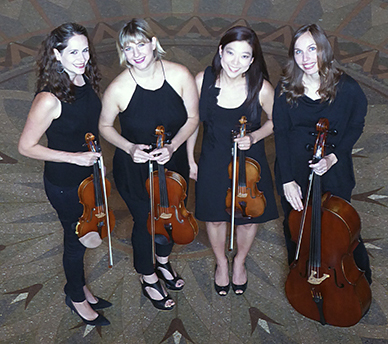by Nicholas Stevens

To dispense with a primary question right away: the players in the group are, to a member, first-rate musicians on both technical and expressive levels. The concert of February 25 brought listeners into the company of six instrumentalists who are also all members of The Cleveland Orchestra. The conditions of the performance, from performer roster and repertoire to acoustics and even natural lighting, almost guaranteed a satisfying outcome.
However, no amount of background knowledge could prepare the listener for the remarkable musicality of the quartet in performances of Mozart’s Adagio and Fugue in c and Quartet in G. From a severe opening statement to a melting subsequent passage, the players showed striking unity of vision in the titular Adagio of the first piece. A lesser ensemble might treat the Fugue as the sort of labored, cerebral exercise that so many music students come to dread — yet the quartet proved to be not only a well-oiled machine, but also profoundly expressive in its approach to the movement’s every twist, turn, tune, and countermelody. Not mechanical but ferociously alive, the ensemble rendered this opening Mozart composition with an organic, responsive, and often athletic approach.
The quartet shows a consistent collective character, a signature sound. This became even more apparent in the G-major Quartet. Set apart by a certain elasticity of gesture, the group shows both an openness to individual agency and an ability to snap suddenly into focus as a collective whole. First violinist Amy Lee-Rosenwein proved a fine leader throughout the Quartet, placing delightfully off-kilter accents on the primary tune of the Menuetto and showing off her compelling solo sound — dark and visceral, perfect for quartet playing — in the Andante cantabile.
Second violinist Alicia Koelz has a lovely sound on the lower strings of the instrument, acting as the perfect tonal bridge to the Platonic-ideal viola sound of Joanna Patterson Zakany. Together, these middle-voice players make a great team-within-a-team, always in motion but never overactive. Ell serves as both foundation and equal partner in group conversation, bringing modern muscularity of sound to this 18th-century vision of chamber music.
After an intermission, Isabel Trautwein — a violinist, here playing viola — and cellist Paul Kushious joined the quartet to play Brahms’s Sextet in G. The players levitated together at the start of the opening Allegro non troppo, soon expanding into textures that found the violins reaching toward the heavens, the violists flowing forward in characteristic Brahmsian fashion, and the cellists grounding all in earthy basslines. The Scherzo had the quality of a time-lapse video of clouds passing over mountaintops. The Adagio grew progressively to a peak of intensity, and in the final Poco Allegro some late afternoon light began to stream through a west window and illuminate the players from the side — an apt visual metaphor for this energetic yet clearly valedictory closing movement.
Published on ClevelandClassical.com February 26, 2018.
Click here for a printable copy of this article



